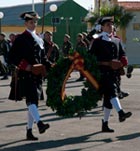MENÚ UNIDAD
ARMY UNITS
- Araba Álava |
- Albacete |
- Alicante |
- Almería |
- Asturias |
- Ávila |
- Badajoz |
- Barcelona |
- Burgos |
- Cáceres |
- Cádiz |
- Cantabria |
- Castellón |
- Ceuta |
- Ciudad Real |
- Córdoba |
- A Coruña |
- Cuenca |
- Girona |
- Granada |
- Guadalajara |
- Gipuzkoa |
- Huelva |
- Huesca |
- Islas Baleares |
- Jaén |
- León |
- Lleida |
- Lugo |
- Madrid |
- Málaga |
- Melilla |
- Murcia |
- Navarra |
- Ourense |
- Palencia |
- Las Palmas |
- Pontevedra |
- La Rioja |
- Salamanca |
- Segovia |
- Sevilla |
- Soria |
- Tarragona |
- Santa Cruz de Tenerife |
- Teruel |
- Toledo |
- Valencia |
- Valladolid |
- Bizkaia |
- Zamora |
- Zaragoza

Background
- pagination
-
BRIEF HISTORY OF ITS EVOLUTION
On May 2nd, 1710, King Philip V promulgated the Royal Ordinance that, in its 9th article, created the Royal Artillery Regiment of Spain. Initially organized in three Battalions, the first was assigned to the Army of Aragon, headquartered in Valencia, to guard the military positions in that Kingdom and those of Catalonia, Valencia, Navarra and Gipuzkoa. This Artillery Battalion was the basis of the current 4th Coastal Artillery Regiment, the first name of which was "1st Battalion of the Royal Artillery Regiment of Spain", and it dates, as mentioned above, from May 2nd, 1710.
On January 29th, 1762, Charles III promulgated the Reglamento de Nuevo Pie (New Foot Regulations), a project undertaken by the Count of Gazola in which he ordered that the Royal Artillery Corps be established. Four Battalions were created in said Regulation, and the 4th Battalion of the Royal Artillery Corps was garrisoned in Valencia, until 1785 when it was transferred to Alicante, because "the noise of the Artillery shots disturbed the silkworms, damaging the Harvest".
At the request of Manuel Godoy (Generalissimo of the Armies), a new Artillery Ordinance was drafted, which was approved on July 22nd, 1802. Therein, five Foot Artillery Regiments were organized from the four abovementioned battalions. Said Regiments were established in each of the existing Artillery Departments. Thus, in Cartagena (2nd Department), the 2nd Foot Artillery Regiment would be constituted based on the existing 4th Battalion, to serve the districts of the kingdoms of Valencia, Murcia and Aragón. Later, in 1806, a new reorganization would establish the location of the 2nd Regiment in Valencia, although it would still remain for some time in Cartagena.
When the Spanish War of Independence began on May 2nd, 1808, the HQ of the Regiment and all its Companies except one were in Cartagena.
On July 1st, 1814, after the War of Independence, it was provisionally ordered to return to the organization of 1806 (from four Regiments to two Battalions each), the Regiment in Valencia being reorganized under the name of 2nd Foot Artillery Regiment.
At the beginning of 1823, the 2nd Foot Artillery Regiment was summoned to Cartagena and after the "One Hundred Thousand Sons of St. Louis" on October 1st of the same year, the Army was disbanded, leaving only a few Platoons made up of those who had served in the Royal Armies. In Valencia, there would remain a "provisional 2nd Foot Artillery Battalion".
By Royal Ordinance of April 23rd, 1824, a Foot Artillery Battalion was reorganized again in Valencia, with eight Companies. From this and with another Battalion created in that city on September 28th, 1824, the 2nd Foot Regiment was organized on October 11th, 1825, with two Battalions.
In 1828, it was once again reduced to the "Foot Artillery Battalion" of the 2nd Department, due to the prevailing peace. But in 1835, due to the Carlist War, it became a Regiment again, continuing in Valencia.
In 1843, the Provisional Government, which replaced the Regency, ordered that all the Platoons of the Corps be constituted into Brigades. The 2nd Regiment would be composed of two Brigades; the 2nd Battalion took the name 2nd Brigade and its Companies took the name Batteries.
In 1859, the Brigades of the Foot Regiments were again called Battalions.
In 1862, a new deployment of the Corps forces was carried out, the 2nd Foot Regiment (with its two Battalions) being assigned, by Royal Order of May 5th, from Valencia to Cartagena, a city in which it would remain until the month of February 1864, the date on which it moved to Madrid, settling with its Headquarters at the Carabanchel Camp. In May of the following year, it would move to Madrid capital. By Royal Order of November 18th, 1866, it was ordered to return to Cartagena, and this took place the following May.
At the end of 1868, a new deployment took place, and in order to relieve the 3rd Foot Artillery Regiment, which had been assigned to Carabanchel (Madrid), the 2nd Foot Artillery Regiment arrived in Cádiz by rail on the night of December 18th, coming from Cartagena. It did so only with its 2nd Battalion, carrying its Purple Flag, with the Red Cross of Burgundy. The 1st Battalion was still in the area with its Batteries distributed between Valencia and the Balearic Islands, arriving in Cádiz on February 9th of the following year, doing so in the war steamer “Vulcano”. Both the 2nd Battalion, and later the 1st would be housed in the “Bomba” Barracks. At that time, the Regiment covered, in addition to Cádiz and Ceuta, the detachments of Málaga, Chafarinas, Alhucemas, Algeciras, Tarifa, San Fernando and Santa Cruz de Tenerife.
Later, in 1883, with the reform of Martínez Campos, the Foot Regiments were transformed into Garrison Battalions. The 2nd Foot Artillery Regiment was divided into two independent Units; its 2nd Battalion became the 2nd Foot Artillery Battalion, garrisoned in Cádiz, being comprised of six companies and one Depot, and providing detachments to Malaga, Seville, Tarifa, Algeciras and San Fernando.
By Royal Order of December 26th, 1884, and with the new organization of the Artillery Corps, it was renamed "2nd Garrison Artillery Battalion".
When, in 1904, it changed its name to the Garrison of Cádiz Artillery Commandancy, it inherited the ancient tradition of the Garrison of Cádiz Artillery Command, which dates back to the year 1589, in which King Philip II appointed the legendary Sebastián de Estopiñán to the position of Lieutenant of Captain General of the Cádiz Artillery.
In 1918, the word Coast appears for the first time in the name of this Unit, when it was renamed "Coast of Cadiz Artillery Commandancy".
In 1924, it was called the 1st Coastal Artillery Regiment, to which was added the qualification “Mixed” in 1943; then simply Artillery Regiment of the Coast of Cadiz in 1947; in 1957, it was the 4th among the Arms Regiments, recovering three years later the adjective mixed, becoming the 4th Mixed Artillery Regiment. Since 1985, it has had the current name, 4th Coastal Artillery Regiment, and it was known as such when it was transferred, on May 22nd, 1992, to Camposoto, in the so-called Isla de León, municipality of San Fernando (Cádiz), where it constituted a garrison and occupied the facilities where what was then known as the 1st GACTA (1st Coastal Artillery Group) was already stationed, which occupied artillery positions that had been operating since 1789.
During the second half of 2002, this Group became the Mobile Coast Group, being equipped with 155/52 SBT APU Towed Howitzers. On the occasion of the Organizational Adjustments carried out in the Spanish Army, at the end of 2008, the 2nd Coastal Artillery Group—comprised of the batteries deployed in the Tarifa area, equipped with 152.4 mm and 381mm Vickers materiel—disappeared..
As of January 1st, 2010, and as a consequence of the application of Regulation 04/09 on Organizational Adjustments, the General Headquarters of the MACTA (Coastal Artillery Command) and the GRULI (Location and Identification Group)—depending on the former, which were integrated into the 4th Coastal Artillery Regiment—disappeared.
-
MAIN COMBAT ACTIONS
OF THE 1ST BATTALION OF THE ROYAL ARTILLERY REGIMENT OF SPAIN
1713-1714 The first action in which there is evidence that the forces of the 1st Battalion participated was during the Siege of Barcelona conducted by Philip V from July, 1713, to September 12th, 1714, to conquer said city.
1717 Expedition to Sardinia.
1718 First Italian Campaign.
1727 Second Siege of Gibraltar.
1732 Reconquest of Oran.
1734 Second Italian Campaign.
1741-1748 Third Italian Campaign.
OF THE 4TH BATTALION OF THE ROYAL ARTILLERY CORPS
1779 Third Siege of Gibraltar and Reconquest of Menorca.
1782 Resumption of the Siege of Gibraltar.
1793-1795 Roussillon campaign.
OF THE 2ND FOOT ARTILLERY REGIMENT:
1807 Expedition to Denmark under the command of the Marquis de la Romana. Expedition to Portugal with General Solano's Division, participating in the blockade of Lippe Castle in YELVES.
Spanish War of Independence:
1808 Defense of Valencia, Battle of Alcolea, Battle of Bailén, Battle of Somosierra, Defense of Tudela and Second Siege of Saragossa.
1809 Battle of Alcañiz, Talavera Campaign, Archbishop's Bridge, Battle of Ocaña and Siege and Defense of Tortosa.
1810 Surrender of Ciudad Rodrigo.
1811 Defense of Badajoz, Tarragona, Oropesa, Sagunto and Muyviedro, Operations of the Army of the Center.
1812 Second Siege of Valencia, Taking of Ciudad Rodrigo.
1813-1814 Siege of Peñíscola.
War of the Americas:
1815 Expedition to Lima and Havana.
First Carlist War:
1835 Operations of the Army of the North.
1836-1837 Action of Lucena del Cid, Taking of Ripoll, actions of San Quirde de Besora, Chiva, Manlleu and Dorria.
1838 Capture of Gandesa, Actions of Utrilla and Muniesa, defense of Alcañiz, siege of Morella, etc.
1839 Actions of Alcalá de la Selva and Manzanera.
1840 Siege and capture of the Castle of Aliaga, attack and surrender of Morella, the Castles of Alpuente and Begís and operations of the Army of the Center.
Political events:
1844 Blockade of Alicante.
1845 Events in Valencia.
1848 Events in Madrid.
Hispano-Moroccan War:
1871 Defense of the Garrison of Melilla.
Political Events:
1873 Actions in Andalusia, the Cádiz incidents and the sieges of Cartagena.
Third Carlist War:
1874 Operations in Extremadura.
1875 Operations in Tafalla, Oteiza and Montesquinza and Attack on Santa Bárbara, Battles of Castelltersols, siege of Igualada and encounters in Ballinas and Capellades.
OF THE 2ND GARRISON ARTILLERY BATTALION:
1893 Operations in Melilla.
1895 Reinforcements to Artillery Battalions embarked for Cuba and the Philippines.
OF THE GARRISON OF CÁDIZ ARTILLERY COMMANDANCY:
RIF campaign:
1909 Operaciones en Melilla.
KERT campaign:
1911-1913 Operations in Larache and Alcazarquivir.
OF THE CADIZ COAST ARTILLERY COMMANDANCY:
Campaign in the RIF and YEBALA:
1921 Operations and battles in Melilla.
1922 Operations in the area of Tetouan, Zoco-el-Arbaa, Timisar, Gorgues, Regaiya and Arseluj.
OF THE 1ST COASTAL ARTILLERY REGIMENT:
Morocco Campaign:
1925-1926 Expedition to Ceuta and detachments and battles in Alcázar-Seguer and Alhucemas. Defenses of the Borras, Palomas and Ordaz positions. Battles of Axdir.
Civil war:
1936-1939 Actions in the city of Cádiz as a result of the proclamation of the State of War, Defense of the Garrison and the provincial coastline, Operations in the Sierra de Cádiz, Operations at the Córdoba and Estepona Fronts, with the Bourbon column and Capture of Malaga, Operations with the Army of the North, Santander Front, Capture of Bilbao, Operations in Extremadura.
-
FLAG.
Through a Royal Decree of 1707 Felipe V stated "that each Corps brings the white Colonel Flag with the Red Cross of Burgundy... to which I have ordered to add two castles and two lions in the four whites and four crowns that close the tips of the blades".
 Upon the creation of the Royal Artillery Regiment of Spain, by Royal Ordinance of May 2, 1710, in its article 21, it is ordered that each battalion should have three regulatory flags like the other infantry regiments, at the same time it was said that they should carry some artillery badge that distinguishes them from those of the infantry regiments.
Upon the creation of the Royal Artillery Regiment of Spain, by Royal Ordinance of May 2, 1710, in its article 21, it is ordered that each battalion should have three regulatory flags like the other infantry regiments, at the same time it was said that they should carry some artillery badge that distinguishes them from those of the infantry regiments.Therefore, the Colonel Flag of the Regiment assigned to the first Battalion must have been white, incorporating the Royal Coat of Arms a few years later.
That is why the flag that is represented below must have been held by the first Battalion of the Regiment.
It is unknown when the Colonel Flag ceased to be used. It is also unknown when the Purple Flag with which the Regiment arrived in Cádiz was provided to it. Although it is known that this color began to be used in the artillery flags from 1828, and that despite all stated by the Royal Decree of 1943 on the unification of colors of all flags, the purple artillery flags that existed would continue to be used by units that already had them.
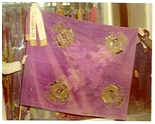
Arriving in Cádiz, on the night of December 18, 1868, the 2nd Battalion of the 2nd Foot Artillery Regiment, carried the Flag that the Unit used uninterruptedly until April 1931, date of the establishment of the Second Republic. It was deposited in the Army Museum by superior order.
It was made of silk satin, purple in color, displaying in its center and in the form of diagonals the Red Cross of Burgundy, with national coats of arms on the four peaks adorned with white and light purple flags; From the moharra hung several ribbons with golden fringes in the red, white and purple colors, with inscriptions, corresponding to denominations of the Unit, such as 2nd Foot Battalion or Artillery Command.
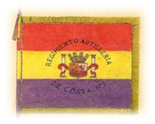
Donated by the Cádiz City Council, the flag was replaced in the act held in the Plaza de San Juan de Dios. In the center of the tricolor flag, the coat of arms of the Republic and the inscriptions "REGIMIENTO DE ARTILLERIA" above and "DE COSTA Nº 1", below.
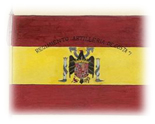
At the beginning of the Civil War, in 1936, the previous flag was provisionally replaced by a simple two-color flag, made by the Unit itself. Later, in 1938, the Cádiz City Council would donate the definitive one, to which the tie of the Military Medal would be imposed, according to the Decree of June 20, 1940, for the actions of the Regiment on the days of 18 to 22 July 1936.
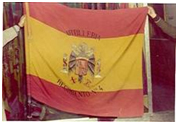
This Flag was replaced by a Banner donated by the Cádiz City Council on October 7, 1969. On it, the coat of arms of Spain and the inscription ARTILLERIA above, and REGIMIENTO MIXTO Nº. 4 below, stood out against the colors of the National Flag.
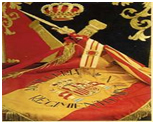
The current Banner was donated by the Cádiz Provincial Council on June 4, 1983. On it, the coat of arms of Spain and the inscription ARTILLERIA above and REGIMIENTO MIXTO Nº 4, below, stands out against the colors of the National Flag.


